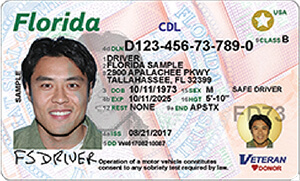- Updated for March 2025
- Based on 2025 FL commercial driver's license manual
Free Florida CDL Permit Practice Test: General Knowledge 2025
To obtain a Commercial Driver’s License (CDL) in Florida, there is a series of requirements you must meet. There are three classes of CDLs. A Class A CDL allows you to operate combination vehicles with a Gross Combination Weight Rating (GCWR) of 26,001 pounds or more in which the towed vehicle weighs more than 10,000 pounds. This is the class of CDL you must get to drive semi-trucks or tractor-trailers. A Class B CDL allows you to operate a single vehicle with a Gross Vehicle Weight Rating (GVWR) of 26,001 pounds or more, or to tow a vehicle that does not exceed 10,000 pounds. This license is suitable for large buses and straight trucks, including most dump trucks. A Class C CDL allows you to operate relatively smaller vehicles designed to transport hazardous materials or 16 or more occupants (including the driver). Decide which class of CDL you want to apply for, based on the types of vehicles you expect to be driving in your career.
Before you can obtain a CDL, you must become proficient in commercial driving. To practice commercial driving (under supervision), you must obtain a Commercial Learner’s Permit (CLP). And for that, you must submit to a medical examination and pass the official General Knowledge written test. That’s where we come in.
The official Florida Commercial Driver License Manual contains all the information covered by the questions on the official knowledge test. But it’s written like a reference work, not like a textbook to facilitate self-study. One better study tool is our set of General Knowledge practice tests like this one. The structure and content of this free Florida CDL permit practice test are similar to those of the official test. It’s also up to date as of March, 2025. On this practice test, you’ll find 50 questions on such topics as backing, driving on downgrades, cargo management, driving emergencies, stopping distance, and Florida driving laws. But unlike the official test, each of our practice questions includes a helpful hint and an explanation of the correct answer.
So, what is driving in Florida like? If you’ve lived there for some time, you probably already have an idea. It can be gorgeous in much of the state, the winter envy of Northerners battling frigid winds, blizzards, and Nor’easters. Florida is the only continental US state with a tropical climate (south of Lake Okeechobee). But with that climate can come heavy rainstorms and thunderstorms, and even hurricanes (especially from August to October).
Test-taking tip: Read all answer choices carefully before you select one. One or more answers may seem plausible – but you must select the best or most complete answer.
- Perfect for first-time and renewal CDL/CLP applicants, and those adding endorsements
- Triple-checked for accuracy
What you need to know

What to expect on the actual FL DMV exam
questions
correct answers to pass
passing score
List of questions (classic view)
- What is the main reason to perform a vehicle inspection?
- Which of the following is NOT a key steering system component?
- The minimum tire tread depth for the front tires is
- How many reflective warning triangles must you carry with you for emergencies?
- Your vehicle's safety equipment must include
- Why should you use a helper when you're backing your vehicle?
- The most important hand signal that you and a helper should agree on is
- Which of the following statements about retarders are true?
- When going down a downgrade in a vehicle with an automatic transmission, you should
- To shift up, you should release the accelerator, push in the clutch and shift into neutral, and then
- Total stopping distance equals
- Where should you place your warning devices if you must stop on a one-way road or divided highway?
- According to the Florida CDL Handbook, how far ahead should you look while driving?
- If you double your speed, how much more distance will it take to brake to a stop?
- Why should you keep your tires properly inflated?
- What is the best way to check what is going on behind and to the sides of your vehicle?
- "A truck's braking distance is shorter when it's empty than when it's fully loaded." True or false?
- In which of the following conditions is hydroplaning most likely?
- What is the best way to figure out how many seconds of following distance you have?
- Avoid swinging left before you turn right because
- If another driver is tailgaiting you, the best course of action is to
- You should inspect wheel bearing seals for
- If you are driving a 30-foot vehicle at 55 mph, you should leave how many seconds of following distance?
- What is the definition of a hazard?
- If you feel drowsy while driving, what should you do?
- Letting the air out of hot tires
- Getting only _______ or less of sleep the night before your trip will triple your risk of an accident.
- When you start to drive down a steep downgrade, which of the following should influence your choice of speed?
- Which of the following is MOST likely to get stuck on raised railroad crossings?
- How long does it take a typical tractor-trailer to clear a double railroad track?
- When you're about to start down a steep downgrade, you should
- An antilock braking system (ABS)
- Which of the following should you NOT do if you experience a tire failure?
- How can you determine if your vehicle is equipped with an antilock braking system (ABS)?
- An A:B:C type fire extinguisher can work on which of the following types of fires?
- What is a common cause of tire fires?
- What can you do at an accident scene to help avoid another accident?
- Which of the following is most likely to cause a vehicle fire?
- Hazardous materials placards are
- Signs of a drunk driver include all of the following EXCEPT
- In Florida, if you are convicted of drugged driving that resulted in an accident, you may face which of the following penalties?
- What will help a drunk sober up?
- How many tie-downs are required for a 20-foot load?
- If you don't have enough weight on the front axle,
- Before transporting a sealed load, you must check
- Once you start your trip, you must inspect the securement of your cargo within
- Why should you cover your cargo?
- In Florida, to pass an emergency vehicle that is stopped on the side of a multilane roadway, you must move into a non-adjacent lane – if it's safe to do so. Otherwise, you must slow down to
- Under Florida law, which of the following drivers must hold a CDL?
- To transport cargo safely, which of the following are you NOT responsible for?
FAQs
How do you obtain a CDL in Florida?
To get a CDL in Florida, start by obtaining a commercial learner’s permit (CLP) after passing the required knowledge tests. Hold the CLP for a minimum of 14 days, then complete CDL training (optional but recommended) and pass the skills test. Ensure you meet all medical and legal requirements.
What is the cost of getting a CDL?
The cost for a CDL in Florida includes various fees: $75 for the CDL, $10 for the knowledge test, and additional fees for endorsements. CDL training schools may have separate charges.
Is CDL school mandatory?
CDL school is not mandatory in Florida, but it is highly recommended to ensure proper training and increased chances of passing the skills test. Some employers may require CDL training.
What are the different types of CDL?
In Florida, CDL types include Class A (for combination vehicles like tractor-trailers), Class B (for heavy straight vehicles), and Class C (for vehicles carrying hazardous materials or more than 15 passengers).
How long does CDL training last?
CDL training duration in Florida varies by program and individual pace. It typically ranges from a few weeks to several months, depending on whether you choose full-time or part-time training.
How much is a first-time CDL?
A first-time CDL license in Florida costs $75. This fee does not include costs for the knowledge test, skills test, medical examination, or any training courses you may opt to take.
- Alabama: Test 1 / Test 2
- Alaska: Test 1 / Test 2
- Arizona: Test 1 / Test 2
- Arkansas: Test 1 / Test 2
- California: Test 1 / Test 2
- Colorado: Test 1 / Test 2
- Connecticut: Test 1 / Test 2
- Delaware: Test 1 / Test 2
- District of Columbia: Test 1 / Test 2
- Florida: Test 1 / Test 2
- Georgia: Test 1 / Test 2
- Hawaii: Test 1 / Test 2
- Idaho: Test 1 / Test 2
- Illinois: Test 1 / Test 2
- Indiana: Test 1 / Test 2
- Iowa: Test 1 / Test 2
- Kansas: Test 1 / Test 2
- Kentucky: Test 1 / Test 2
- Louisiana: Test 1 / Test 2
- Maine: Test 1 / Test 2
- Maryland: Test 1 / Test 2
- Massachusetts: Test 1 / Test 2
- Michigan: Test 1 / Test 2
- Minnesota: Test 1 / Test 2
- Mississippi: Test 1 / Test 2
- Missouri: Test 1 / Test 2
- Montana: Test 1 / Test 2
- Nebraska: Test 1 / Test 2
- Nevada: Test 1 / Test 2
- New Hampshire: Test 1 / Test 2
- New Jersey: Test 1 / Test 2
- New Mexico: Test 1 / Test 2
- New York: Test 1 / Test 2
- North Carolina: Test 1 / Test 2
- North Dakota: Test 1 / Test 2
- Ohio: Test 1 / Test 2
- Oklahoma: Test 1 / Test 2
- Oregon: Test 1 / Test 2
- Pennsylvania: Test 1 / Test 2
- Rhode Island: Test 1 / Test 2
- South Carolina: Test 1 / Test 2
- South Dakota: Test 1 / Test 2
- Tennessee: Test 1 / Test 2
- Texas: Test 1 / Test 2
- Utah: Test 1 / Test 2
- Vermont: Test 1 / Test 2
- Virginia: Test 1 / Test 2
- Washington: Test 1 / Test 2
- West Virginia: Test 1 / Test 2
- Wisconsin: Test 1 / Test 2
- Wyoming: Test 1 / Test 2
Your go-to, trusted source
Experience the Driving-Tests differenceOur commitment to accuracy and quality in our practice tests
Explore our rigorous, multi-tiered verification process that ensures each question mirrors the official manual for unparalleled accuracy.

At Driving-Tests.org, we understand the importance of reliable and accurate practice tests to help you prepare for your DMV exam. That's why we've developed a meticulous process to create and continually update our practice questions, ensuring they reflect the most current driving laws and regulations.
Here's an inside look at how we maintain the highest quality in our practice tests.
Content Creation and Verification Process
- Alignment with Official Manuals:
Every question we develop is based on the most recent version of each state's official driving manual. Our team regularly monitors each state DMV's website for the latest updates to ensure our practice tests are always aligned with the most current information. - Community Feedback Integration:
We leverage feedback from our vast community of users to understand which topics are most frequently tested. This helps us focus on the areas that are most relevant and beneficial for your preparation. - Expert Content Creation:
Our in-house editor, Steven, who has extensive experience in driver education, crafts each question with precision. He conducts a thorough review of each question against the official manuals to ensure accuracy. - Rigorous Review Process:
Once Steven has finalized a set of questions, our team conducts a joint review session. This second level of scrutiny involves content accuracy, proofreading, and fact-checking to eliminate any errors. - User Feedback Mechanism:
After a question goes live on our site, we keep the lines of communication open. Each question features a feedback button, inviting users to report any issues or errors. This continuous feedback loop allows us to address and rectify any concerns promptly. - Responsive Updates:
In line with our commitment to accuracy, we quickly update our practice questions to reflect any changes in the DMV manuals. Additionally, we update the free electronic copy of the state's driver's license manuals on our site, typically within a few days after the DMV publishes them.
Our thorough quality control process ensures that you have access to practice tests that are as accurate and up-to-date as possible. We believe in the power of well-prepared drivers and are dedicated to providing you with the best study tools to help you succeed on your DMV exam.
Pass the First Time – Guaranteed
You’re moments away from your results.
Before you view them, see how 1.15 million drivers used Premium to pass faster.
Real Exam-Like Florida Questions
Get all exam-like questions seen on the real test.
99.06% Pass Rate vs. 49% Average
Most Premium users pass on their first try.
Money-Back Guarantee
We stand behind you until you pass.




